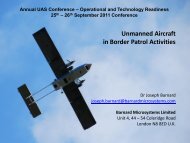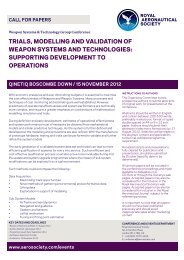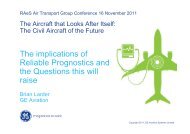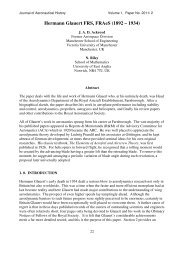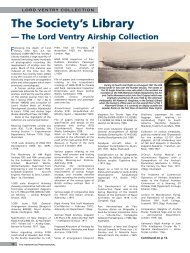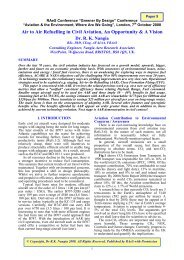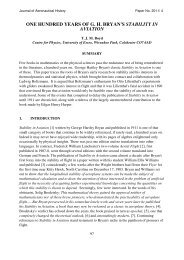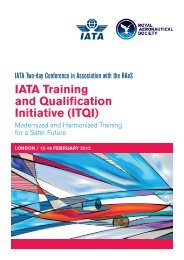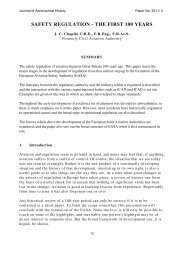DTS Paper.qxp - Royal Aeronautical Society
DTS Paper.qxp - Royal Aeronautical Society
DTS Paper.qxp - Royal Aeronautical Society
Create successful ePaper yourself
Turn your PDF publications into a flip-book with our unique Google optimized e-Paper software.
The two current major military aerospace programmes are Typhoon (left), now entering service, and F-35 Lightning II (right) which made its first<br />
flight in December 2006.<br />
1.0 BACKGROUND<br />
1. The MoD has now completed the first iteration of its long-term<br />
strategy for the UK defence technology and industry base (DTIB).<br />
Its approach to the industrial component was outlined in the<br />
Defence Industry Strategy (DIS) paper of December 2005 2. The DIS<br />
has been now complemented by the Defence Technology<br />
Strategy (<strong>DTS</strong>) published in October 2006. Together these<br />
documents and other ministerial statements set out a 20-25-year<br />
perspective for UK defence procurement and research<br />
investment. This is the most comprehensive policy for the DTIB<br />
ever published by the MoD. While not necessarily offering a<br />
detailed prescription for future procurement decisions, the DIS<br />
and <strong>DTS</strong> present a framework, a set of guiding principles and an<br />
indication of priorities for both the MoD and industry. As such,<br />
they have been welcomed by industry as a means of guiding its<br />
investment with a higher degree of confidence than hitherto and<br />
enabling companies to play their full part in meeting MoD<br />
requirements over the next decade.<br />
2. This paper discusses the implications for the UK aerospace<br />
industry of the MoD’s DTIB policy as expressed in the DIS and the<br />
<strong>DTS</strong> 3. It briefly recapitulates the main themes of the two<br />
documents with specific reference to the aerospace sector.<br />
However, the main focus is on the 20-25-year technology strategy<br />
and the likely direction this implies for the UK aerospace industry.<br />
A 50-year perspective is not unrealistic given that the F-35/JSF will<br />
be in front line service for much of this period and Unmanned<br />
Airborne Systems (UAS) concepts will shape air power delivery<br />
whatever the specific platform characteristics they may possess.<br />
3. As the UK sets out to celebrate the first 100 years of manned<br />
aviation and of the first steps in the evolution of a domestic<br />
aircraft/aerospace industry, the following conclusions offered may<br />
be unsettling: the future of combat aviation will certainly confirm<br />
the shift away from aerospace as such to airborne systems, with<br />
conventional manned fixed and rotary wing aeroplanes largely<br />
2 Ministry of Defence, Defence Industrial Strategy, December 2005 and<br />
Ministry of Defence, Defence Technology Strategy, October 2006.<br />
3 A <strong>Society</strong> view on the DIS was expressed in a memorandum submitted<br />
to the House of Commons Defence Committee, Seventh Report of<br />
Session 2005-06 Defence Industry Strategy, HC 824, May 2006.<br />
providing tactical and logistic support. This will imply on the one<br />
hand a different industrial supply chain and on the other<br />
domestic vulnerability to increased global competition. The DTIB<br />
strategy will undoubtedly help UK industry to make the necessary<br />
adjustments and transition to a new business model, but the<br />
process will not be easy nor without casualties.<br />
2.0 THE UK DEFENCE TECHNOLOGY AND<br />
INDUSTRY STRATEGIES — MAIN THEMES<br />
The changing context of defence technology acquisition<br />
4. The defence environment is changing and at faster rate than at<br />
perhaps any time since the end of WW2. As the <strong>DTS</strong> puts it:<br />
“Never has there been greater uncertainty in the nature of the<br />
threat faced by the UK, nor has that threat adapted and changed<br />
so rapidly. This demands rapid evolution in our response, both<br />
tactically and in the technologies we deploy to combat the<br />
threats.” 4 The DIS “provided greater transparency of the MoD’s<br />
future defence requirements and, for the first time, set out those<br />
industrial capabilities needed to ensure we can operate our<br />
equipment in the way we choose.” The <strong>DTS</strong> is designed to provide<br />
a “highly innovative, agile and flexible” approach to defence<br />
research. The key word being ‘strategic’, with an emphasis on<br />
meeting the MoD’s ‘core needs’, which includes a ‘clear emphasis’<br />
on Through Life Capability Management (TLCM) and a<br />
‘comprehensive engagement’ between MoD and its collaborative<br />
partners and its technology supply base.<br />
Appropriate Sovereignty<br />
5. Underpinning both the DIS and the <strong>DTS</strong> is the concept of<br />
Appropriate Sovereignty. The MoD recognises that a significant<br />
proportion of its equipment needs will be satisfied by overseas<br />
suppliers or foreign-owned companies located in the UK. Foreign<br />
ownership per se is not a problem for the MoD as long as the<br />
work and technology remains on on-shore. The DIS tries to tell<br />
industry “very clearly where, to maintain our national security<br />
and keep the sovereign ability to use our Armed Forces in the way<br />
we choose, we need particular industrial capabilities in the UK.”<br />
Appropriate Sovereignty has three dimensions: strategic<br />
4 <strong>DTS</strong>, A1.1<br />
FEBRUARY 2007 5



